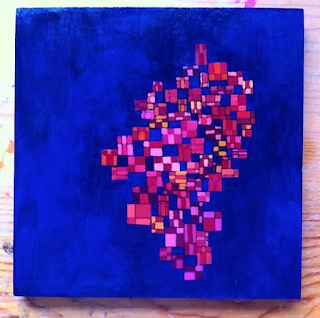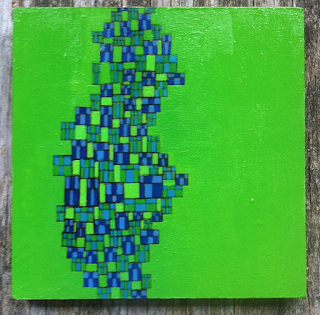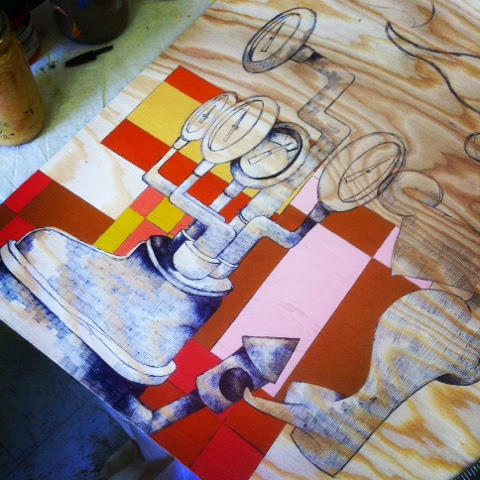I’ve had the Vestibule Gallery lined up for a couple months now. The space is prime; located right on Congress Street in downtown Portland, ME. I haven’t even had a solo show in Portland since 2005 and that was in a coffee shop. Needless to say I’ve been trying to put something good together, to the point where I’d have to say I was overthinking it.
Category: Pattern
Creating art with an audience seems at once both daunting and inspiring. Even the most casual visitor to the studio often breaks my concentration for hours. At the same time, I have long wanted to create a mural or some other piece of public art. I enjoy the idea of artwork that is immediately accessible to a broad audience and not simply limited to gallery visitors and the sadly endangered creatures we know as “art collectors.” I have had some limited experience with viewing my work in a public environment. In 2011, I participated in the Billboard Art Project in New Orleans. It was incredible seeing my work at that scale with the actual earth and sky as the backdrops to my representative imagery. That experience left me wanting for a more permanent experience, however. While I was able to see my artwork on a grand scale, I did not experience the process of painting in the midst of the public; creating under observation.
It was with great pleasure, then, to be approached my Meg Shorette, of Launchpad and Central Gallery, to participate in the Queen City Piano Project. Meg and her crew of volunteers placed 5 pianos in parks throughout Bangor, ME. Each piano was to be hand-painted and designed by a different artist. I immediately could see my random and spontaneous patterns working their way across the body of a piano. It seemed to me the best opportunity I had had thus far to paint on a piece of found material and to create in the public. Coupled with this excitement was also the fear of becoming some sort of natural history exhibit or feeling like an animal penned up on display in the zoo. I imagined greetings from the public a la Steve Irwin. “Well, look ‘ere, mate. I’s an a’tist in ‘is natu’al habitat. Let’s poke him, eh?”
I have always envisioned my favorite artists, like McGee and Jasper Johns to be impervious to an audience, capable of focusing on their artwork at all times, while conversing with visitors or not. Jackson Pollack seemed dependent on an audience while painting, to validate his creative act, his performance. Alternatively, I was reading a blog post by Janice Mason Steeves in which she claims that she needs a space to herself in order to create work of consequence and quotes one of my favorites, Franz Kafka, who apparently couldn’t bear an audience.
“You once said that you would like to sit beside me while I write. Listen, in that case I could not write at all. for writing means revealing oneself to excess; that utmost of self-revelation and surrender, in which a human being, when involved with others, would feel he was losing himself, and from which, therefore, he will always shrink as long as he is in his right mind…That is why one can never be alone enough when one writes, why there can never be enough silence around one when one writes, why even night is not night enough.”
In a blogpost on painting a hallway, writer, Paul Kleiman, talks about Stanislavski’s “Circle of Concentration,” the idea to choose your area of focus. He suggests that when you are painting you are able to reduce your area of focus to the spot right in front of you on your painting, noticing its irregularities and the movements of your brush only.
In truth, my studio practice is very much like this. It is all about solitude and the zen sensibility that a paint brush, palette and surface will elicit. It is about rhythm an motion and being in tune with the surface. I felt that this was a very private endeavor, but when I made it to Pierce Park to paint my piano, I found myself able to shrink my focus, to still create like I was in private. For all intents and purposes, I was by myself. I was unaware of the world around me but for the surface in front of me, but only using the idea of the “circle of concentration.”
I dove into my piano without a clear image of what I wanted it to look like in the end. I stuck with the locked box set of rules that I have been using in many of my patterns recently. The shapes of included in the patterns are all rectangles and vary only slightly within my locked box vernacular. The patterns grow spontaneously; one shape at a time in relation to the previous shapes. I was thinking about Thelonious Monk and Ahmad Jamal while drawing and painting this project, trying to solo using the limited locked box rules as jazz scales. The result seemed to be the most mature realization of the pattern making that I have experienced thus far.
I had relatively few visitors while finishing up the piano, but the people who did visit were interesting to talk with and seemed pleased to have a piece of public art available in the small city of Bangor. Due to my thoughts of jazz soloing, the experience seemed performative even when there was no one there. Ultimately, I found it compelling to create in an arena where people could see me working, enjoy the progress of the work, and take ownership of the process. I hope to create more work in the public sphere in the future. It felt as though the work was co-authored by the community that I was working in and that the work had a purpose to a wider audience.
Peace
-mike
I read a piece today on Ornette Coleman, by Miles Bullough, while settling into studio. I was fascinated to read that bop king Dizzie Gillespie didn’t even think of Coleman’s playing as jazz. The article went on to explain that Coleman didn’t receive any formal education and didn’t follow any of the previously accepted modal and measured solos. Rather he played what felt right and sounded right to him in a spontaneous moment. The head, or lead in the number would play, and then the sounds would be off to run the gamut. I slipped The Shape of Jazz to Come on today after reading the article. There was something in that album that felt so in tune with what I am doing in the “Gridlock” Series. It is a spontaneity, an improvisation, but not one that has definitive rules. It is more of a puzzle, finding the right piece to fit in response to the previous shape, with some basic intent at a cohesive whole, but nothing explicit.
Coleman’s wandering bars seemed like just the fit to my shapes and as I added color to finish up my pieces, I started listening to Charles Mingus, Live at Antibes, one of my favorite albums. “Folk Forms” is one of my favorite jazz pieces. It aspires to this same sort of mindset, I think. Fitting the current piece with the previous piece. Don’t obsess too much about the whole, because the decisions that you make are innate. Let the artwork or music be.
It is important for me to allow this side of my brain to be. When I over think work or focus too definitively on the details of the work, it never seems to happen. I create a dud. Only when I allow my intuition to take over to I find the peace of mind to make a successful work. The successful work is a conversation, not in words translated to paint, but in paint to paint.
Peace
-Mike
UThis summer has been so very trying on my creativity. I took a job in an art gallery and seemingly lost my creative mojo. There were so many works around me, very few of which I wanted to feel any influence by, and on the whole my little brain has felt completely an utterly overwhelmed. Compounded with the amount of time that the job takes up I feel like I have been in for it.
In response to the large gauge piece with cool grids as the ground, I have started two smaller pieces which are to function as a diptych.
Moving is such a drain on creativity, resources both financial and mental, and time. Since my wife and I found out that we had to move, we have had our noses to the ground trying to make a bit more money, find a house, and keep ourselves sane. Throughout this process the only thing that has kept me okay is sharing my friend Shirah’s studio space. I have a show coming up in February and another in May. I have several projects on the drawing boards that I wish to give my attention so much more than I want to give my attention to a move that at times I feel so completely nonplussed by.
That said, there is no way around the move. It will happen, and so, that studio space has become a bit of a safe haven for me. Recently I began to think about the pieces that I was making in the different divided segments on the 6″ X 6″ panels. I wondered if I couldn’t combine the ideas of pattern that I had been studying in Franz Boas’s Primitive arts with the ideas behind those segmented images. Franz Boas suggested that patterns change vertically but become repetitive or symmetrical to the left and right. This mimics change in our everyday setting. Consider the skyline, treeline and land. They are three different segments to our everyday which change vertically but repeat in a sense laterally.
I have always felt like I work better in constrained proportions. Long vertical or horizontal pieces have always seemed more comfortable to work in than the traditional canvas shapes. When I have been stacking these pieces I’ve realized that I am actually creating a different type of pattern. Check out the images below.
In addition, I’ve been trying to do more index card pieces for the show in February. It is a show of advice and words of comfort from media, relatives and my own sketchbooks. These word based pieces have struck me as slightly uninteresting as of late, but this morning I started using one of the new sketchbooks that my wife got me for Christmas. I started to think about the word based pieces as text out of silent movies. Here is the result.
The patterns grow. I am beginning to think of words as a really complicated pattern. That is all that a pun really is; manipulating the patterns that we have created for letters. I’m off to studio for a bit more work. I hope you enjoyed the images.
Peace
-Mike
This afternoon during Experimental Painting class I finished The Dangling Man, Saul Bellow’s first novel. Saul Bellow’s characters always bear such a sense of solitude. In Dangling Man, Joseph is waiting for the draft board to call for nearly a year and in the meantime, slowly loses his sense of control and balance, but also gains a sort of comfort with the solitude. It is a feeling that I am often curious about. Much of art is this solitude. Until my recent marriage, the majority of my studio days were accompanied only by feline companions. To be sure I played a variety of music in studio and listened to a number of podcasts and different musicians but at the end of the day an art practice is a quiet practice. It is one that has traditionally been accomplished in solitude. What of this type of man in wait for his calling? Joseph was waiting to be called by the draft board. Is that so different than waiting to hit your big break. Eventually we see in Joseph that his inability to act, which is exacerbated by his depression which is in direct correlation to his loneliness and lack of purpose, becomes the very source of his lack of happiness.
With this in mind, I started to think about my ability to act. I have been taking some solid steps in the right direction these past few months, but still have a couple major steps on the way to success. An inability to act on these steps will only result in loneliness and depression, or as the rock band AC/DC put it back in the 70’s, “It ain’t no fun waiting ’round to be a millionaire.” I’ve got to take some action and it is important for me to prioritize these actions.
In contrast to this thought I have also been very much involved with a new series that I am producing for Art Stream Studios’ “Off the Grid” show coming up in December. All work is 6″ X 6″ and under $250. I started these four panels by painting a color pattern field in the back. Actually, to be fair, I indicated the colors, mixed them and laid the panels out like paint by numbers for my studio assistant. You can read about that a bit over on my Tumblr blog, which she has taken over as a sort of process diary from the studio assistant perspective. It is certainly different hearing these perspectives from outside of my own head, but I digress. As I looked at these color field paintings, I had originally planned on doing a few more pipe and drop pieces, but realized that that had nothing to do with the way that I was feeling about this show.
I started to think about the ordered chaos of the color patterns. None of the shapes were really the same scale. The colors alternated back and forth and so the pattern was the same but the color and size varied from piece to piece. They were all very much related but would never be mistaken for being in the same pattern. They fit together more like a quilt. Recently I had been visiting my nieces and had broken my favorite coffee mug which they have set aside for me at their house for some five or six years now. I have since found one which I use at my own house, but that has only been in use for maybe 2 years. I thought about how objects hold some of that relationship, working as a sort of totem and concluded that I needed to do a series of mugs over the top of these patterns. It would serve as my source of mental pause over top of the ordered chaos that is the world these days.
This first mug is the mug which I spoke of that my nieces would always hand me. It carries with it my memories of my past relationship, the roots of a couple fantastic friendships and a family which is not really mine but which I will always feel is mine.
This second mug is a mug which I purchased on a trip back to Seattle after I had moved away the second time. I was staying with my friend Jill in her First Hill studio apartment, where she had shown me images from her recent trip to India and her adoption of Buddhism. It was a defining moment in my life. Her apartment was so simple and cozy. We had tea. We lived quietly those two nights and she worked very hard. The morning after I finished staying there we had coffee at Victrola on Pike Street. I left with this mug and it now carries that story with it for all time.
My father was a forest ranger in New York State, as followers of this blog well know. There were two mug designs that I remember from growing up. There was this one and one with a simple green tree on a very tiny mug. This commemorative mug is the mug that holds my paint brushes. While drawing this mug I couldn’t help but think of Jasper Johns castings of his mug and brush set up, but also was taken with thoughts of my dad, and drinking coffee at home.
It is a little odd to be drawing from life and perhaps a bit odder to find so much meaning in these inanimate objects, but it seems natural and I really like the way the pieces are coming out. I’m doing at least two more; one more for Art Stream and an additional one of the mug that I won at a muzzle loading match with my father in the 90’s for my folks. Coffee mugs have always been my family’s jam.
Peace
-Mike






















